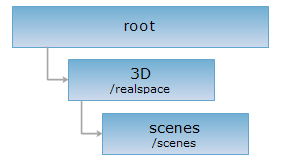<3D_uri>/scenes[.<format>]
The scenes resource includes a set of all 3D scenes, providing information about all 3D scenes in the current 3D service.
Please refer to the development guide for more information about this resource usage: Get 3D layer list.
Supported methods
Supported output formats: RJSONJSON, JSONP, HTML, XML.

Below is an example of performing an HTTP request on a specified URI with rjson as the output format. supermapiserver in the URI is the name of the server.
http://supermapiserver:8090/iserver/services/3D-sample/rest/realspace/scenes.rjson
Gets a list of all 3D scenes.
| Field | Type | Definition |
| _cache | boolean | [Optional parameters] Whether to use cache, the default is True. False means close all the cache. |
Performing a GET request on the scenes resource returns a set of 3D scene descriptions, each one with the following structure:
| Name | Type | Description |
| name | String | The name of the 3D scene. |
| path | String | The path for accessing the 3D scene resource. |
| resourceConfigID | String | ID of the resource configuration. |
| resourceType | String | Resource type. |
| supportedMediaTypes | String[] | Supported media types for descriptions. |
Performing a GET request on the example scenes resource returns the following resource description in rjson format:
[{
"name": "scene",
"path": "http://supermapiserver:8090/iserver/services/3D-sample/rest/realspace/scenes/scene",
"resourceConfigID": "scene",
"resourceType": "ArithmeticResource",
"supportedMediaTypes": [
"application/xml",
"text/xml",
"application/json",
"application/rjson",
"text/html",
"application/jsonp",
"application/realspace"
]
}]
Returns the same HTTP response header as GET does, but no response entity is included. HEAD request can be used to get metadata from the response message header without transporting the entire response content. Metadata includes information about the media type, character encoding, compression encoding, the length of the entity content, etc. The HEAD operation of the image resource can also have request parameters similar to those in the GET operation.
HEAD request can be used to check if the scenes resource exists and can be accessed by clients. It can also determine if the scenes resource supports an output format <format> if performed on a URI with .<format> included.